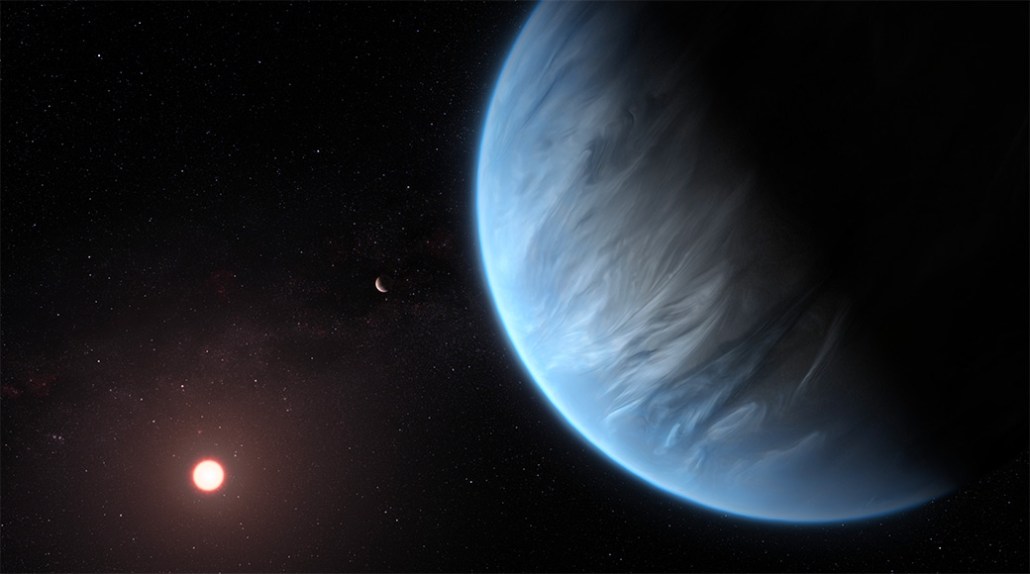
Exoplanet K2 18b (illustrated here) has water vapor and possibly rain clouds in its atmosphere, but that doesn’t mean it can host life.
M. Kornmesser/Hubble/ESA
- More than 2 years ago
Few science questions have more universal appeal than “Are we alone in the universe?” The search for alien life has captured human imaginations for thousands of years. And almost 25 years after the first discovery of a planet orbiting a star that’s not the sun, astronomers are closer than ever to finding out.
“Most people, if not everybody, at some point in their life wonders if there’s life on other planets,” says Harvard University astronomer David Charbonneau. “We could actually answer it … we know what kind of telescope we’d have to go and build” to find out.
That endeavor may not be so straightforward, though, thanks to a long-simmering debate about how to identify the planets most likely to host life. The debate came to a boil on September 11, when astronomers announced the discovery of water vapor in the atmosphere of nearby exoplanet K2 18b (SN: 9/11/19).
The planet’s appeal comes from its position in its star’s “habitable zone” — often defined as the region where temperatures may be just right for liquid water, thought to be crucial for life. K2 18b may even have rain clouds, astronomers reported.
That doesn’t mean you should pack your umbrella and go. “Just because a planet is in the habitable zone, doesn’t mean it’s habitable,” says Jessie Christiansen, an astrophysicist at Caltech and NASA Exoplanet Science Institute. “If you queried 100 astronomers, 99 of them would say this planet isn’t habitable.”
In fact, of the 192 or so exoplanets known to spend most of their orbits in their stars’ habitable zones, all but 24 are probably inhospitable gas giants like Jupiter. And even if a rocky planet sits in the habitable zone, like Mars, that doesn’t guarantee anything can live there. Scientists consider the Red Planet to have debatable chances of hosting life (SN: 1/10/18).
Slim pickings
Of the 4,118 exoplanets discovered as of October 1, only 24 might meet the criteria for habitability: They have a mass and radius that suggest a rocky Earthlike surface, and orbit most of the time at a distance from their star that supports liquid water.
Known exoplanets, sorted by potential habitability
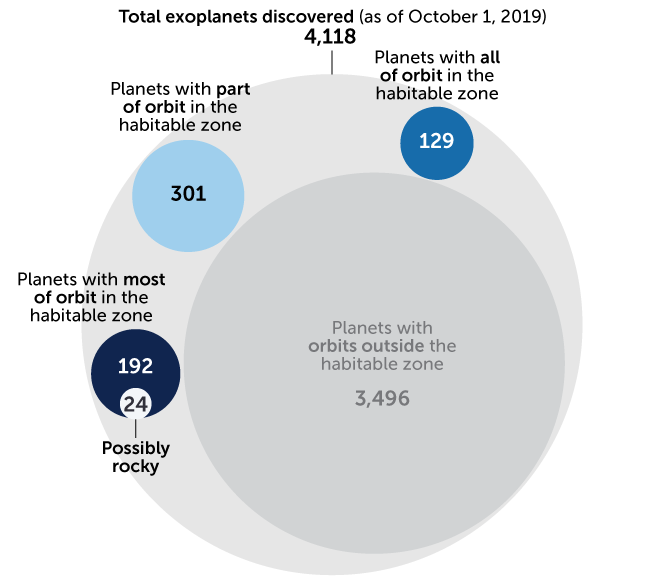
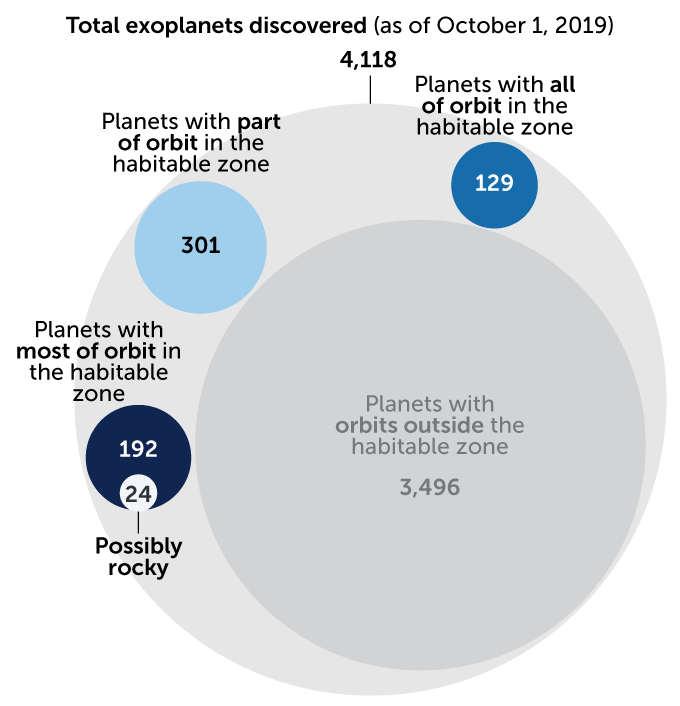
Source: hzgallery.org, S.R. Kane and D.M. Gelino/The Astronomy Society of the Pacific 2012
So how do you find a habitable planet while stuck on Earth? Start by rethinking the term’s definition. Some astronomers argue that the term “habitable zone” is too clumsy, including planets with no chance of habitability while excluding others that might be viable. Scientists from various disciplines are looking to mineral physics, chemistry and insights from ecology to refine the concept of habitability.
And new space observatories designed to seek life could be approved by NASA next year. Maybe it isn’t just the words used to define habitability that need upgrading, but the equipment used to find it, Charbonneau says. “We don’t have the right telescopes.”
Not just any planet
From the 1950s, when astronomers talked about finding other, habitable worlds, they focused entirely on planets like Earth. In a 1993 paper in Icarus, geoscientist James Kasting of Penn State University laid the basis for the most popular definition of “habitable zone” in use today: It’s the “Goldilocks” region where temperatures would be not too hot or too cold for liquid water. But that criterion doesn’t apply to all planets within a habitable zone: Kasting’s model works only for a rocky planet with an Earthlike atmosphere, made up of carbon dioxide, water and nitrogen.
“Any type of planet can orbit in the habitable zone,” but only such Earthlike planets are likely to have liquid water on their surfaces, says astrophysicist Elizabeth Tasker of the Japan Aerospace Exploration Agency. “We all secretly know this, as both the moon and Mars orbit within the habitable zone, but neither have lakeside retreats.”
Back in 1993, there were no known exoplanets around ordinary stars though a few had been found orbiting a pulsar, a fast-spinning stellar corpse (SN: 9/3/15). “I thought it was just entirely theoretical,” Kasting says.
Two years later, though, researchers made the first discovery of a planet orbiting a sunlike star. That planet, 51 Pegasi b, was a hot Jupiter and too close to its star to be in the habitable zone. But it marked the official birth of exoplanet astronomy. And since then, more than 4,000 other exoplanets have been found, with thousands more candidates waiting to be confirmed.
“Things have taken off from there,” Kasting says. “Now it’s an observational field, not a theoretical one.”
Sizes and surfaces
Those two key features — a rocky surface and the right atmospheric mix — are often forgotten amid the excitement of finding a new world in a star’s habitable zone. But there’s reason to think they’re important for a planet’s actual habitability.
If a planet is too gaseous, atmospheric pressures and temperatures will be too intense for complex molecules like DNA to be stable, says astronomer Laura Kreidberg of the Harvard-Smithsonian Center for Astrophysics in Cambridge, Mass. At the interface between a thick, hydrogen-rich atmosphere and a rocky core, for example, temperatures can reach more than 2500° Celsius.
And complex chemistry might be stymied by a phenomenon called the “arithmetic demon.” In a diffuse and gassy atmosphere, it might take too long for atoms to encounter each other, react and form new molecules.
“Both of those — the arithmetic demon and the absence of a surface — are really bad news for forming the constituent pieces that kick-start life on a planet,” Kreidberg says.
That’s part of the problem with K2 18b: It’s not clear that it has a rocky surface. The only way to tell what an exoplanet is made of is to measure its radius, by the amount of starlight it blocks if it crosses in front of its star, and its mass, from its gravitational tug on the star. Together, mass and radius tell scientists the planet’s density, which is a clue to composition. But astronomers can’t always measure both.
Astronomers got lucky with K2 18b, measuring a mass about eight times Earth’s and a radius more than twice Earth’s. That means the world’s has a density similar to that of Mars. While the team that found water in K2 18b’s atmosphere thinks the planet could be terrestrial and rocky, other researchers aren’t so sure.
Small planets tend to split into two groups: rocky super-Earths and gassy mini-Neptunes (SN: 6/19/17). While planets smaller than 1.5 times Earth’s radius seem to be rocky, those around 1.5 times Earth’s radius and larger seem to be mostly mini-Neptunes. K2 18b is much larger than that.
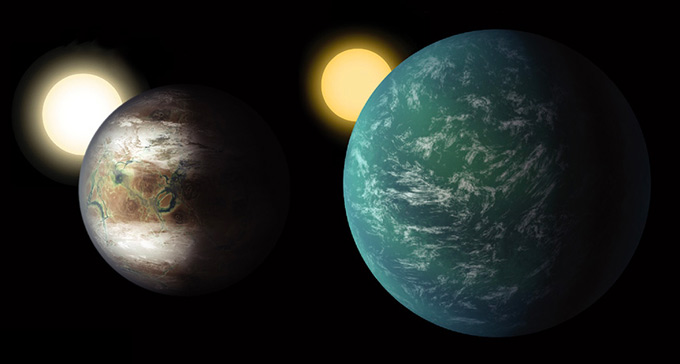
“It’s definitely fluffy,” says Wendy Panero, a mineral physicist at Ohio State University in Columbus. Scientists don’t know much about how rock at the planet’s core would behave at the high temperatures and pressures found deep in a gas planet’s atmosphere. It could be molten lava, or a diffuse boundary where it’s not clear where the atmosphere ends and the rock begins. “We don’t know enough about the material properties of what that interface would be like,” she says.
Knowing a planet’s density also isn’t enough to tell if it has an Earthlike surface. Venus, after all, is nearly the same size and mass as Earth, and sits just a bit nearer to the sun than the habitable zone. But Venus’ atmospheric chemistry sizzles its surface at lead-melting temperatures (SN: 2/13/18).
“Venus is a warning to us that size isn’t everything,” says Stephen Kane, a planetary astrophysicist at the University of California, Riverside. “That planet is screaming at us that planetary habitability is complicated.”
Looking outside the zone
Experiments in geophysics laboratories testing what different minerals do under high pressure and temperature may help refine which worlds are habitable (SN: 5/11/18).
With this research into mineral physics, along with theories about how different types of planets form, “we might be able to say, this planet might be more likely to be Venus versus Earthlike,” says exoplanet geologist Cayman Unterborn of Arizona State University in Tempe.
And some habitable worlds may even be outside the habitable zone. Saturn’s moon Titan, with its lakes and rivers of ethane and methane, is one of the solar system’s most attractive destinations for astrobiology (SN: 6/27/19). Other icy moons of Saturn and Jupiter may host biospheres beneath their frozen shells where conditions sometimes allow for liquid water (SN: 5/2/14). None of them are in the sun’s habitable zone.
“The habitable zone is not the exclusive place where life might be,” says planetary geologist Paul Byrne of North Carolina State University in Raleigh. “Those nuances are hardly ever conveyed when it’s utilized as a place to look for life.”
Just right
The habitable zone — shown in green in this diagram of the red dwarf star K2 18’s planetary system — designates the region around a star where temperatures are thought to be just right for liquid water and therefore life. But orbiting in the zone doesn’t mean a planet is habitable, and orbiting outside the zone doesn’t rule out life.
Mapping a star’s habitable zone
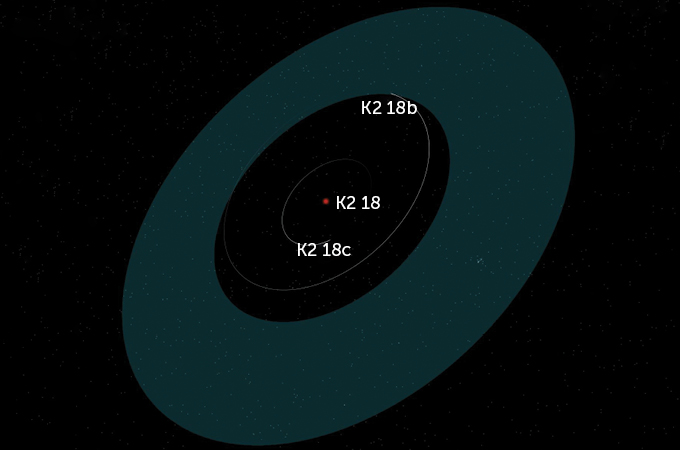
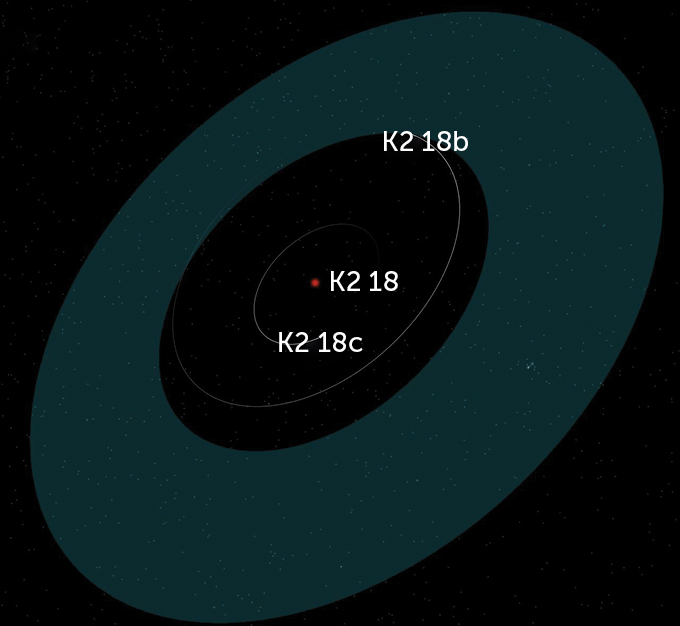
A zone by any other name
Frustrated with the habitable zone’s shortcomings, astronomers have proposed alternative names: the temperate zone, the liquid water zone, the hunting zone (because that’s where astronomers are hunting signs of life) and the ecosphere, to name a few. Kreidberg suggests reviving “Goldilocks zone,” which has fallen out of fashion lately, as a less ambiguous option. Christiansen jokingly suggested the ECHaLWOTS Zone, for “Earth Could Have Liquid Water On The Surface” (pronounced ekkulwots).
“You can instantly see why we’re struggling to find an alternative that might catch on,” Tasker says. Such terms have some of the same problems as the original: Not every planet in the zone, however it is designated, will be temperate or wet, while other candidates could be excluded for not meeting the new definition.
So some astrobiologists are trying to design something like a habitability index that can consider more data and characteristics. In one recent example, astrobiologist Abel Méndez of the University of Puerto Rico at Arecibo took inspiration from ecology.
“Astrobiologists think it’s so hard to measure habitability,” Méndez says. “But ecologists had the same problem in the ‘70s,” when the U.S. Fish and Wildlife Service came up a way to gauge how land and water developments might affect nearby plants and animals. The agency’s Habitat Suitability Index offers a measure of how much biomass can be sustained by a given environment, considering how much energy is available.
Méndez and colleagues modified that index and presented it in 2018 at the Lunar and Planetary Science Conference in The Woodlands, Texas. The researchers’ equation includes five variables in judging a planet’s habitability: the amount of starlight a planet receives, the planet’s radius, its reflectiveness, the fraction of surface covered with ocean and the atmospheric density.
Determining those last three variables is beyond the reach of current telescopes. “This framework tells you exactly what you have to measure,” Méndez says of his team’s habitability index. And he thinks the technology needed could be 10 to 20 years away.
Other astronomers question such an index’s usefulness, given other factors that could influence habitability including an active geological cycle, a molten core, plate tectonics, volcanoes to emit gases into the atmosphere and a magnetic field to protect it from stellar flares (SN: 3/5/18).
Those factors also can’t be detected from Earth. Some may never be.
“You can make a long list,” says Harvard astronomer Charbonneau. “It doesn’t matter if there are microbes hunkered down on a tidally heated moon if I can’t detect them with my telescope.”
Forget habitability, just look for life
A pair of proposed telescopes may soon provide the ability to skip forward to searching directly for signs of life.
“If you want to know for certain that you can pack your bags and go there, you need a biosignature” — a sign that life has altered the chemistry of the planet’s atmosphere, says Kane (SN: 4/19/16). “If we detect unambiguous biosignatures, that means by definition the planet is habitable, because something is living there.”
NASA is now evaluating plans for two telescopes which will be able to scan the skies of Earthlike exoplanets. The Habitable Exoplanet Observatory, or HabEx, would take photos of a dozen or so Earthlike exoplanets orbiting sunlike stars. The Large UV/Optical/IR Surveyor, nicknamed LUVOIR, would do the same, but for up to 100 planets. Both telescopes would look for the chemical imprints of life in the planets’ atmospheres.
“What the next set of instruments is being designed to do is unravel what’s in the atmospheres of these truly Earthlike planets,” Christiansen says.
Still, the concept of a habitable zone is useful for designing projects like HabEx and LUVOIR, Kasting says. Focusing on a particular distance from a star tells engineers how big to make a telescope. Both telescopes’ designs incorporate a 2013 update of Kasting’s earlier definition, from a study led by astronomer Ravi Kopparapu of NASA Goddard Space Flight Center in Greenbelt, Md.
“We’re being conservative, and trying to design telescopes to see something we might recognize,” Kasting says. “It’s pretty difficult to recognize life if it’s not somewhat like us.”
If signs of life are finally found, arguments over the term “habitable zone” might just fade away. Studying actual aliens will give scientists something much more important to talk about.







